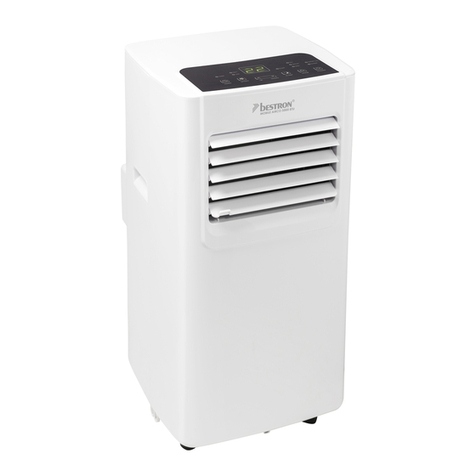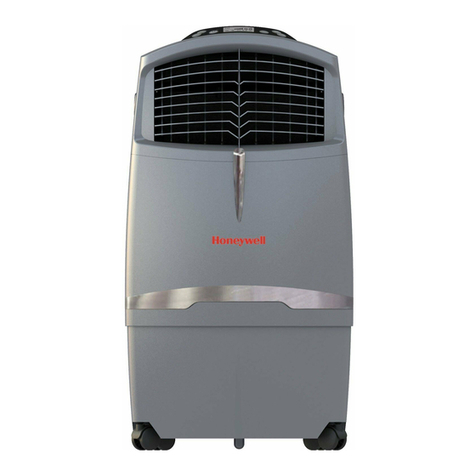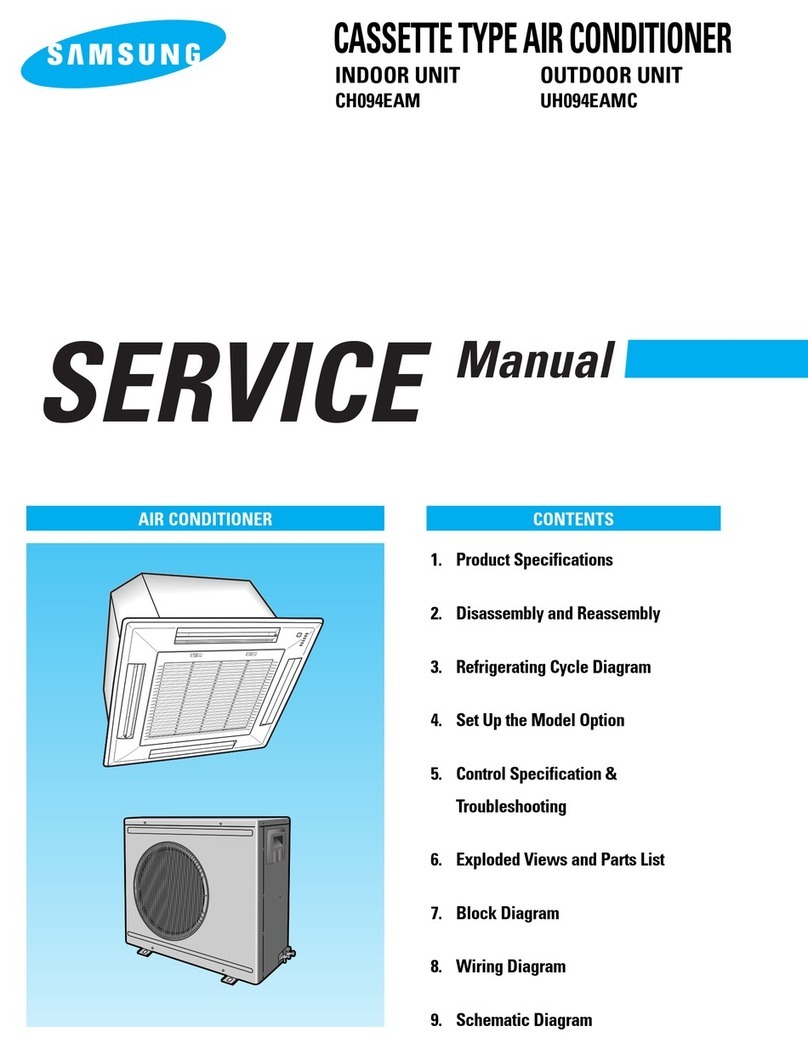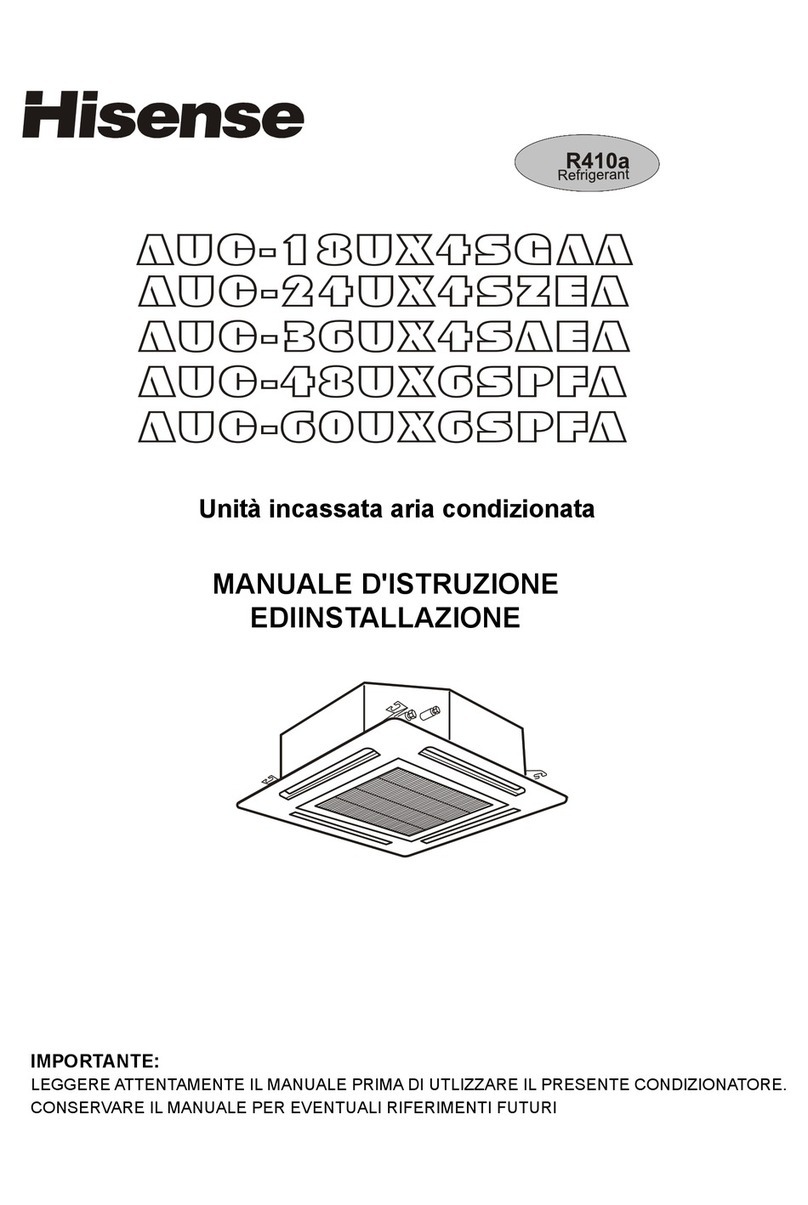ClimateWorx PS6 Series User manual

Series PS6 Vertical Floor-Mount Units
Installation Manual
.cnIlanoitanretnIxroWetamilC
PS6-IM2016 14 Chelsea Lane , Brampton, Ontario, Canada L6T 3Y4

Series PS6 Installation Manual
PS6-IM2016
2

Series PS6 Installation Manual
PS6-IM2016 3
Table of Contents
Table of Contents ................................................................................................................. 3
Site Preparation ................................................................................................................... 4
Location Consideration ....................................................................................................... 5
Positioning of Indoor units................................................................................................5
Positioning of Outdoor Heat Rejection Devices................................................................5
Dimensional Details ............................................................................................................. 6
Electrical Installation .......................................................................................................... 7
Power Feeding...................................................................................................................7
Interconnecting Wiring......................................................................................................7
Refrigerant Pipework Installation...................................................................................... 8
Recommended Pipe Size for Remote Condenser................................................................9
Evacuation.........................................................................................................................9
Fan Speed Control System ................................................................................................ 10
Charging ...................................................................................................................... 10
Head Pressure Control System ......................................................................................... 11
Charging ...................................................................................................................... 11
Chilled-water / Water / Glycol Pipework Installation .................................................... 13
Piping Connection Size:...................................................................................................13
Appendix A: Dimensional Drawings ................................................................................ 14
Appendix B: Piping Schematic Diagrams ........................................................................ 16
Appendix C: Electrical Schematic Diagrams .................................................................. 27

Series PS6 Installation Manual
PS6-IM2016
4
Site Preparation
In order to maximize operating efficiency and performance, the following areas should be observed
at the site-planning stage:
- The room should be surrounded with a vapor seal to eliminate moisture migration through the
building structure. Windows should be sealed and at least double-glazed to prevent sweating.
All door jams should fit tightly and should not have any grilles in them. Polyethylene film type
ceiling, vinyl wallpaper or plastic based paint on the walls and slabs are recommended to
minimize absorption and transmission of moisture into the room.
- Owing to a generally small population, a typical room should have fresh air kept at only about
5% of the re-circulated air. This provides enough ventilation for personnel and pressurizes the
room to prevent dust from entering through leaks. The incoming fresh air must be filtered very
closely, and preferably pretreated. Otherwise heating, cooling, humidifying and dehumidifying
loads of the incoming fresh air should be taken into account in determining total loading
requirements.
- All cables and piping should be carefully routed to lower resistance to the distribution of
conditioned air and to avoid the blockage of air-paths to any portion of the room. As a good
practice, all cables and piping running under the raised floor should be mounted horizontally
and whenever possible, routed to run in parallel with the air-path.
- In order to obtain the most effective air distribution, units should not be located too close
together. Attention should be taken to avoid locating the units in an alcove or an extreme end
of a long narrow room.

Series PS6 Installation Manual
PS6-IM2016 5
Location Consideration
Positioning of Indoor units
The Series PS6 units are designed to be free standing on an accessible raised flooring system
provided with sufficient pedestal supports underneath. A minimum raised floor height of
12” (300mm) or 18” (450mm) for dropping fans into the floor stand is required . However, it is
highly recommended to use a separate floor stand as a support, which is independent of the raised
floor system. This allows the unit to be installed prior to erecting the raised flooring system thus
providing much easier access to piping and electrical connections. The floor stand or unit should be
isolated using a suitable isolation method. ClimateWorx OEM floor stands use a two-nut system for
the floor stand feet. Use both nuts, the top nut for leveling and the bottom nut to lock the leveling
nut in place.
The room layout should provide 27-1/2” (700mm) service clearance in the front of the unit for the
routine service and maintenance. Right-side access increases serviceability.
Note: Units ordered with optional drop down fans should have this step completed once the unit is
secured to the floor stand and the floorstand has been secured and leveled in place. See
dimensional drawing details for this feature.
Positioning of Outdoor Heat Rejection Devices
The outdoor heat rejection devices such as air-cooled condensers and glycol coolers should be
located as close to the indoor unit as possible. From a security and environment standpoint, the
outdoor heat rejection devices should be installed away from public access and occupied spaces
where low ambient sound level is required.
In order to avoid short circuiting and inter unit re-circulation, outdoor heat rejection devices should
be located at least 1.2m (4 ft.) away from any walls or obstructions or 2.4m (8ft), from adjacent
units. To ensure maintenance-free operation, outdoor heat rejection devices should be located away
from the areas that are continuously exposed to loose dirt and foreign materials that may clog the
coil.
The outdoor heat rejection devices should be firmly secured on steel supports or concrete plinths.

Series PS6 Installation Manual
PS6-IM2016
6
Dimensional Details
The following tables summarize the dimensional detail drawing number for Series PS6 units with
standard options. Please refer to Appendix “A” for the dimensional detail drawings.
For units with a special option or configuration, please consult factory for details.
- Downflow Systems
Model -02 -03 -04 -05
PS6 S6DDX600PS6 S6DDX600PS6 S6DDX600PS6 S6DDX600PS6

Series PS6 Installation Manual
PS6-IM2016 7
Electrical Installation
Power Feeding
All models are fitted with a 3-pole main isolator, neutral and earth terminal, which are located at
the lower right corner of the power panel.
The isolator and terminals will accept cables up to AWG #2 (35mm²) gauge. The power cables
should be sized in accordance with local and national codes. Refer to the "Electrical Data" section
in the Technical Data Manual for current requirements.
Interconnecting Wiring
Internal wiring for all Series PS6 is completed and tested prior to delivery. Numbered terminal
blocks for field installed control wiring are provided next to the main power isolator at the lower
right corner of the power panel.
The numbered terminal blocks will accept control wiring up to #12 AWG (4mm²) gauge. The
terminal assignments are listed as follows:
Terminal Function Requirement
11-12 Standby enable Normally open output
13-14 Common alarm (General) Normally open output
21-22 Common alarm (Critical) Normally open output
15-16 Remote on / off Normally open dry contact input
17-18 Standby start Normally open dry contact input
19-20 Fire alarm Normally closed dry contact input
23 thru 28 Condenser/Pump interlock Normally open dry contact output
31-32 Compressor disable (optional) Normally open dry contact input
35-36 Remote on/off Interrupt (optional) Normally open dry contact input
37-38 Unit Status (optional) Normally open dry contact output
39- 42 Custom Fault1/2 (optional) Normally closed dry contact input
43- 44 Liquid High Limit (optional) Normally closed dry contact input
49- 50 Hum/ Reheat disable (optional) Normally open dry contact input
57- 58 Damper Motor Interlock (optional)Normally open dry contact output
59- 60 Damper End Switch (optional) Normally open dry contact input

Series PS6 Installation Manual
PS6-IM2016
8
Refrigerant Pipework Installation
Good practice should always be followed when connecting refrigerant piping in direct expansion
systems.
As many of the operational problems encountered in a refrigeration system can be traced back to
improper design and installation of refrigerant piping, it is essential that the following guidelines be
observed:
- Use clean and dehydrated refrigeration quality tubing with both ends sealed.
- Cut and form tubes carefully to avoid getting dirt or metal particles into the refrigeration lines.
Never use a hacksaw to cut the tubing.
- Once the system is open, complete the work as quickly as possible to minimize ingress of
moisture and dirt into the system. Always put caps on ends of tubes and parts not being worked
on.
- To prevent scaling and oxidation inside the tubing, pass an inert gas such as nitrogen through
the line while carrying out brazing, silver soldering or any other welding processes.
- It is recommended that quality refrigeration solder (95% tin, 5% silver) be used for its
excellent capillary action.
- Use minimum amount of solder flux to prevent internal contamination of the piping. Use flux
with care as it is usually acidic in nature.
- Install a trap at the bottom of the vertical riser of a hot gas line and a trap for every 20 ft. (6m)
in elevation to collect refrigerant and lubrication oil during off cycle. A discharge line trap is
an important function both during the compressor on and during the compressor off cycle.
During the on cycle, the trap collects oil droplets and carries them efficiently up the elevated
discharge line. During the off cycle, the traps captures and retains oil residing on the pipe
walls that would otherwise drain back to the compressor head, causing damage on startup.
- Install inverted trap whenever a condenser is located above the compressor. An inverted trap or
check valve should be installed at the condenser inlet and outlet to prevent liquid refrigerant
from flowing backwards into the compressor during off cycles.
- Insulate the suction line and insulate liquid lines that may be subjected to high heat gains.
Insulate low level discharge lines to avoid burning due to accidental contact.
- Design and arrange refrigerant piping for the remote condenser in such a way so that adequate
velocity of refrigerant can be maintained to prevent oil trapping. Under sizing discharge lines
will reduce compressor capacity and increase compressor load. Over sizing discharge lines
increases the initial cost of the project and can reduce the refrigerant gas velocity to a level
where oil is not returned to the compressor.Recommended pipe sizes are tabulated as follows:

Series PS6 Installation Manual
PS6-IM2016 9
Recommended Pipe Size for Remote Condenser
Hot Gas Line
Model - PS6 -02 -03 -04 -05
50 ft. equivalent pipe length in. 7/8 7/8
7/8 7/8
100 ft. equivalent pipe length in. 7/8 7/8
7/8 7/8
150 ft. equivalent pipe length in. 7/8 7/8
7/8 7/8
200 ft. equivalent pipe length in. 7/8 7/8
7/8 7/8
Liquid Line
Model - PS6 -02 -03 -04 -05
50 ft. equivalent pipe length in. 1/2 1/2
1/2 1/2
100 ft. equivalent pipe length in. 1/2 1/2
1/2 1/2
150 ft. equivalent pipe length in. 1/2 1/2
5/8 5/8
200 ft. equivalent pipe length in. 1/2 1/2
5/8
5/8
Evacuation
The procedure for leakage testing and evacuation of the system is as follows:
1. Disconnect all line voltage fuses except the fuses for control transformers. Using the test mode,
energize fan and all solenoid valves. (See M52 User’s Guide) Open liquid line hand valve.
2. Connect a gauge manifold to the compressor suction and discharge rotalock valve.
3. Close the compressor discharge and suction ports and open all service valves.
4. Charge the system with dry nitrogen to approximately 150 psig (not to exceed 350 psig).
5. Leave pressure in system for at least 12 hours. If pressure holds, continue with next step. If the
pressure drops detect and seal leak before continuing.
6. Release all pressure. Connect a vacuum pump to the compressor suction and discharge
rotalock valves with refrigerant or high vacuum hoses. Provide an isolating valve and a
pressure gauge for pressure checking.
7. Evacuate the system to an absolute pressure not exceeding 1500 microns. Break the vacuum to
2psig with dry nitrogen. Repeat the evacuation process and then re-break the vacuum with dry
nitrogen.
8. Open the compressor discharge and suction ports. Evacuate to an absolute pressure not
exceeding 500 microns. Let the vacuum pump run without interruption for minimum two
hours.

Series PS6 Installation Manual
PS6-IM2016
10
Fan Speed Control System
The fan speed control system maintains not only a constant condensing pressure over a wide range
of climatic conditions but also high sensible cooling for the evaporator so that re-humidification is
rarely required throughout the year.
A pressure-sensitive fan speed controller is employed in the fan speed control system. It regulates
the condenser head pressure at low ambient temperatures by varying the airflow volume through
the condenser.
Upon engaging the interlock contact in the indoor unit, the fan speed controller will directly sense
the changes in the refrigerant head pressure and vary the output voltage from 15% to 97% of the
applied voltage.
Charging
Calculate the total charge required using this formula:
Indoor Unit Charge + Liquid Line Charge + Condenser Charge
+ Hot gas Line Charge = Total Charge
Proper performance of the system depends largely on proper charging. Adhere to the following
guidelines for charging:
1. Open the main isolator and insert the fuses for the fans, control transformers and the
compressor.
2. Close the main isolator and allow the compressor crankcase heater to operate for at least one
hour.
3. Connect the gauge manifold to both discharge and suction rotalock valves, with a common
connection to the refrigerant cylinder. Purge the lines by opening the refrigerant cylinder
vapor valve.
4. Connect the refrigerant cylinder to recovery unit and charge system with 90% of calculated
amount.
5. Start the unit using the test mode to energize the main fan and compressor. Please make sure
outdoor condenser (if any) is powered.
6. Add additional refrigerant to the system until the sight glass is clear of bubbles and
subcooling is measured between 10-15 oF.
7. Run system to maintain a hot gas (discharge) pressure based on refrigerant used (R407C
@240psi and R22 a @225psi) then re-check subcooling, Add refrigerant if subcooling has
dropped below 10 oF.
8. The system is now correctly charged for operating under fan speed control. It is a good
practice to weigh the amount of additional refrigerant that was added and keep a record of the
total charge in the system.

Series PS6 Installation Manual
PS6-IM2016 11
Head Pressure Control System
For condensers possibly subjected to extremely low ambient temperature, it is recommended that a
head pressure control system be installed. This avoids starving the evaporator coil, with the
consequence of oil clogging; short cycling on low pressure control, reduction of the system
capacity and erratic expansion valve operation.
A drop in the condensing pressure often occurs in air-cooled systems as a result of low ambient
conditions encountered during fall-winter-spring operation. Head pressure control renders part of
the condenser surface inactive. The reduction of active condensing surface results in a rise in
condensing pressure and hence provides a sufficient liquid line pressure for normal system
operation. The head pressure control system allows operation at extremely low ambient temperature
down to -40°F.
ClimateWorx uses a two-valve head pressure control with receiver, for factory ordered condensers.
The ORI is located in the liquid drain line between the condenser and the receiver, and the ORD is
located in a hot gas line bypassing the condenser.
During periods of low ambient temperature, the condensing pressure falls until it approaches the
setting of the ORI valve. The ORI then throttles, restricting the flow of liquid from the condenser.
This causes refrigerant to back up in the condenser thus reducing the active condenser surface. This
raises the condensing pressure. Since it is really the receiver pressure that needs to be maintained,
the bypass line with the ORD is required.
The ORD opens after the ORI has offered enough restriction to cause the differential between
condensing pressure and receiver pressure to exceed 20psi. The hot gas flowing through the ORD
serves to heat up the cold liquid being passed by the ORI. Thus the liquid reaches the receiver
warm and with sufficient pressure to assure proper expansion valve operation. As long as sufficient
refrigerant charge is in the system, the two valves modulate the flow automatically to maintain
proper receiver pressure regardless of outside ambient.
Charging
Calculate the total charge required using this formula:
Indoor Unit Charge + Liquid Line Charge + Condenser Charge
+ Hot gas Line Charge + 20% of Receiver volume = Total Charge
When head pressure control is utilized, there must be enough refrigerant to flood the condenser at
the lowest expected ambient and still have enough charge in the system for proper operation. After
completing the evacuation procedures as in the fan speed control system, follow the following
guidelines for charging:

Series PS6 Installation Manual
PS6-IM2016
12
1. Open the main isolator and insert the fuses for the fans, control transformers and the
compressor.
2. Close the main power and allow the compressor crankcase heater to operate for at least one
hour.
3. Connect the gauge manifold to both discharge and suction rotalock valves, with a common
connection to the refrigerant cylinder. Purge the lines by opening the refrigerant cylinder
vapor valve.
4. Connect the refrigerant cylinder to recovery unit and charge system with 90% of calculated
amount.
5. Start the unit using the test mode to energize the main fan and compressor. Please make sure
outdoor condenser (if any) is powered.
6. Add additional refrigerant to the system until the sight glass is clear of bubbles and
subcooling is measured between 10-15 oF.
7. Run system to maintain a hot gas (discharge) pressure based on refrigerant used (R407C
@240psi and R22 a @225psi) by adjusting ORI valve(s) then re-check subcooling, Add
refrigerant if subcooling has dropped below 10oF.
8. The system is now correctly charged for operating under head pressure control at the ambient
temperature charging is being carried out. It is a good practice to weigh the amount of
additional refrigerant that was added and keep a record of the total charge in the system.
9. If the system is designed to operate at ambient below the ambient that exists during charging,
additional charge will have to be added now.
Method to Determine Additional Refrigerant Charge to Operate to an Expected Minimum Ambient Temperature
Example for KS11-078-1 Ambient Temp at Time of Charging = 60°F
to Operate to -30°F
Step 1. At the ambient temperature at the time of charging the system (e.g 60°F)
Read from the table – % of Condenser to be Flooded (e.g - 10 %)
Step 2. At the expected minimum ambient Temperature (e.g - - 30 °F )
Read from the table - % of the Condenser to be Flooded (e.g - 77 %)
Step 3. Calculate the difference of the above two values
( 77 % - 10 % = 67 % )
Step 4. From the “ Air Cooled Condenser Guide” read Winter Flooded ( -40°F )
Refrigerant Charge ( 6.4 lbs )
Step 5. Multiply the value found in Step 4 by the difference in %’s calculated
in Step 3.
Additional Required Charge = 6.4 lb * ( 67 % ) = 4.30 lb / Condenser
( If Two (2) Circuit Condenser 2.15 lb / Ref Circuit

Series PS6 Installation Manual
PS6-IM2016 13
Chilled-water / Water / Glycol Pipework Installation
The Chilled-water / Water / Glycol pipework should be installed in accordance with the following
recommendations:
- A manual shut-off valve should be installed at the supply and return pipes of each indoor unit
for routine service and emergency isolation of the unit.
- Joints installed inside the room must be kept to a minimum. The system drain discharge point
should be installed outside the room.
- Piping inside the building should be insulated to eliminate the possibility of condensation
under low ambient conditions.
- Always use the reverse return system when two or more indoor units are served by the same
source.
- For condensing water supplied from a cooling tower, adequate filtration and an inhibitor
should be added in correct quantities to prevent the formation of scale and corrosion.
- Only ethylene glycol containing a corrosion inhibitor should be used. Automotive anti-freeze
is unacceptable and must not be used in the Glycol system.
- Concentration of glycol required depends on the minimum ambient temperature. The
following glycol concentration is recommended:
% of ethylene glycol by weight Minimum operating temperature °C (°F)
10 0 (32)
20 -5 (23)
30 -11.6 (11)
40 -20 (-4)
50 -32.2 (-26)
Piping Connection Size:
Model no. suffix 02 03 04 05
Liquid line -odm 1/2 1/2 1/2 1/2
Hot gas line -odm 5/8 5/8 5/8 7/8
Humidifier drain -odm 3/4 3/4 3/4 3/4
Humidifier water in -odm 1/4 1/4 1/4 1/4
Cooling coil condensate -odm 3/4 3/4 3/4 3/4
Chilled water (when req’d) -odm 1-1/8 1-1/8 1-1/8 1-1/8
Condenser water (when req’d) -odm 1-1/8 1-1/8 1-1/8 1-1/8
Glycol solution (when req’d) -odm 1-5/8 1-5/8 1-5/8 1-5/8
Odm – Outside diameter of copper pipe in inches for soldering

Series PS6 Installation Manual
PS6-IM2016
14
Appendix A: Dimensional Drawings
Drawing Title Drawing No.
PS6 - Downflow Dimensional Detail S6DDX600PS6

Series PS6 Installation Manual
PS6-IM2016 15

Series PS6 Installation Manual
PS6-IM2016
16
Appendix B: Piping Schematic Diagrams
Drawing Title Drawing No.
PS6 – Chilled Water System Schematic PS6DS401
PS6 – Air Cooled System Schematic PS6DS100
PS6 – Air Cooled System Schematic with Hot Gas Bypass PS6DS103
PS6 – Water Cooled System Schematic PS6DS200
PS6 – Water Cooled System Schematic with Hot Gas Bypass PS6DS300
PS6 – Glycol Cooled System Schematic PS6DS200
PS6 – Glycol Cooled System Schematic with Hot Gas Bypass PS6DS300
PS6 – Dual Chilled Water System Schematic PS6DS502
PS6 – Air Dual Cooled System Schematic PS6DS505
PS6 – Water Dual Cooled System Schematic PS6DS503
PS6 – Glycol Dual Cooled System Schematic PS6DS504
PS6 – Glycol Free Cooling System Schematic PS6DS501

Series PS6 Installation Manual
PS6-IM2016 17

Series PS6 Installation Manual
PS6-IM2016
18

Series PS6 Installation Manual
PS6-IM2016 19

Series PS6 Installation Manual
PS6-IM2016
20
Table of contents
Other ClimateWorx Air Conditioner manuals
Popular Air Conditioner manuals by other brands

Mitsubishi Electric
Mitsubishi Electric MS-GK36VAT operating instructions
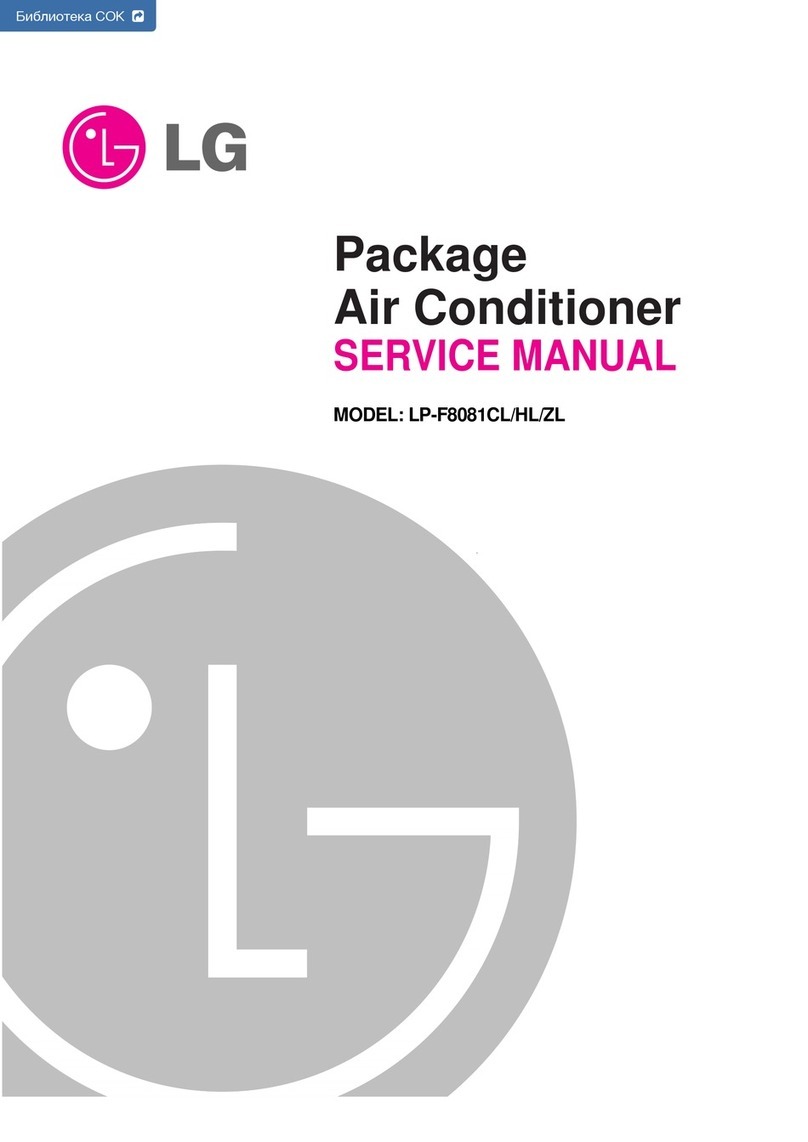
LG
LG LP-F8081CL Service manual
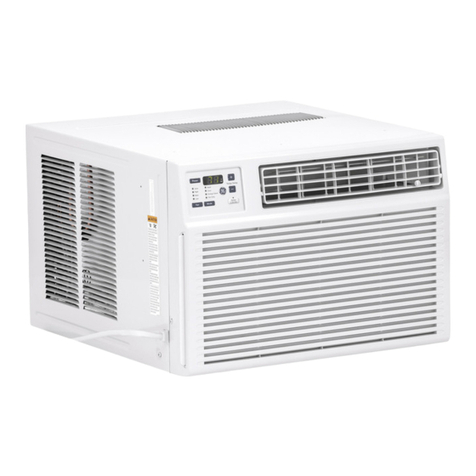
GE
GE AHE18 Series Owner's manual and installation instructions

Haier
Haier 1U25MECFRA-3 Service manual

Daikin
Daikin GTKY50UV16V2 Operation manual
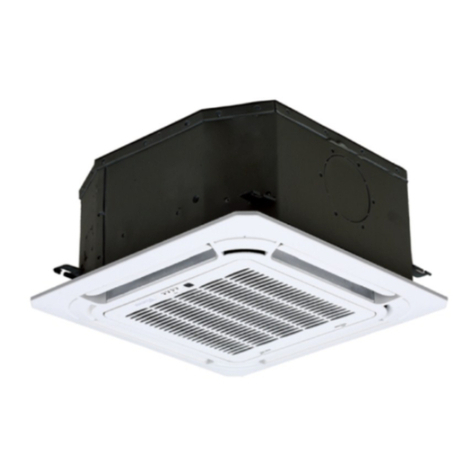
Frigicoll
Frigicoll MKD-V300 Installation & owner's manual

Daikin
Daikin FTXN25L Service manual

Ocean Breeze
Ocean Breeze OBZ-10ESN owner's manual
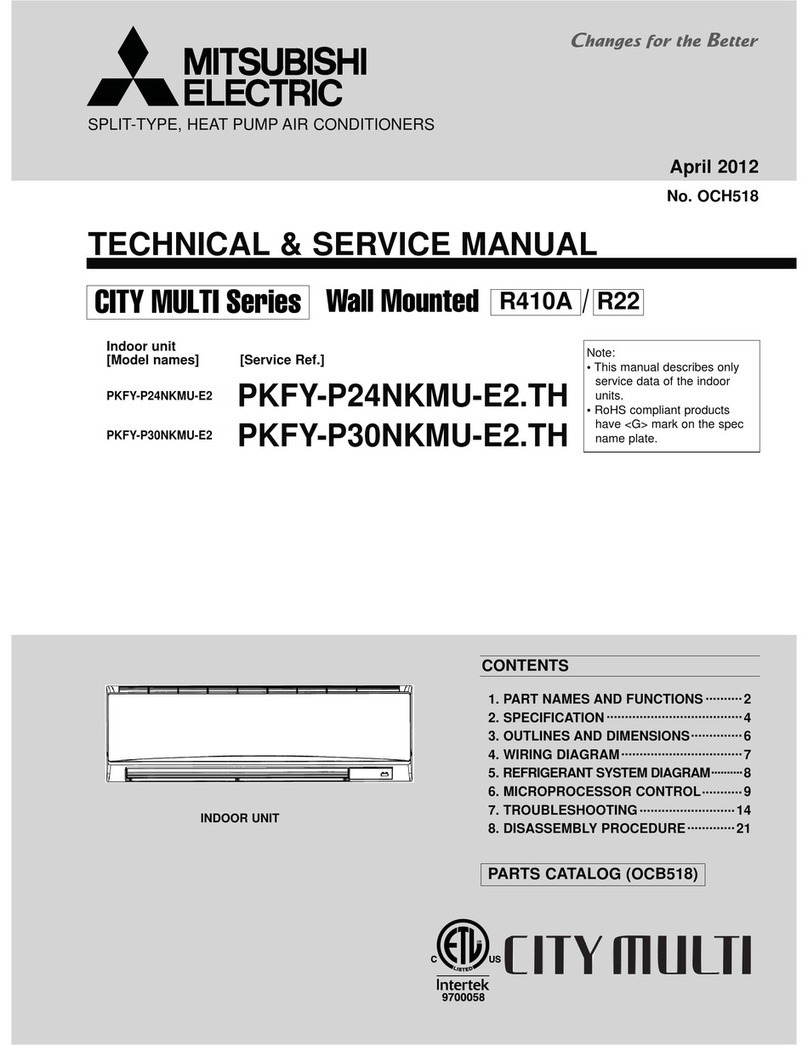
Mitsubishi Electric
Mitsubishi Electric City Multi Series Technical & service manual
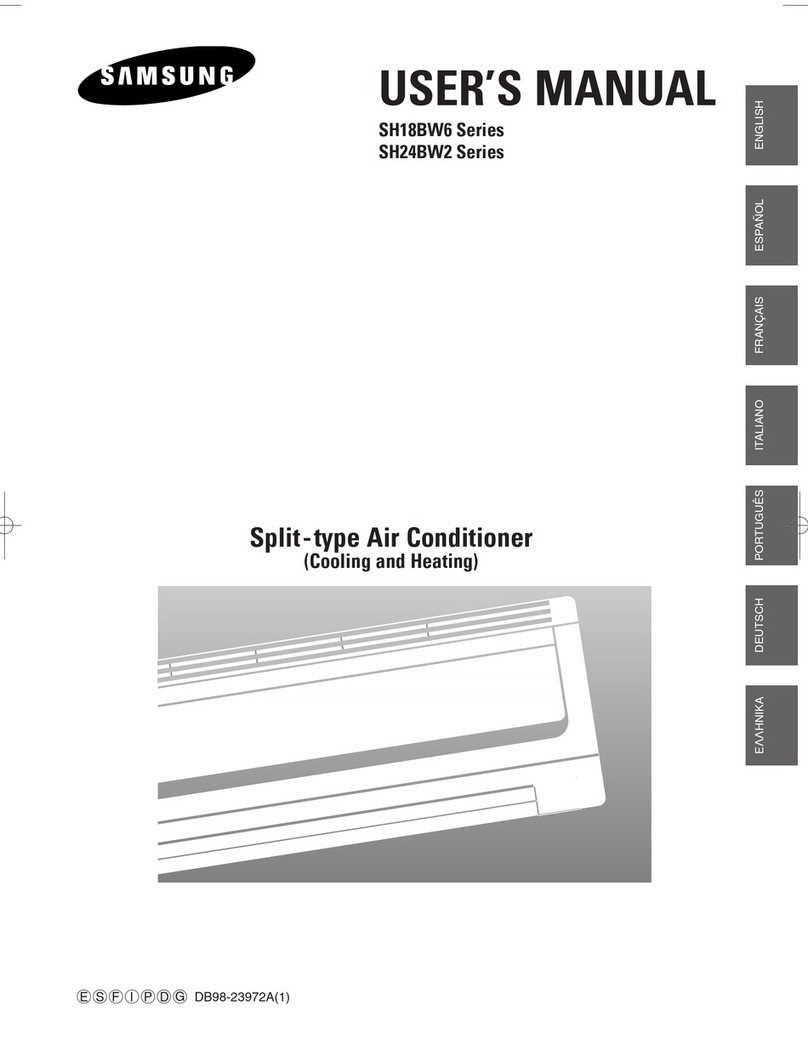
Samsung
Samsung SH18BW6 Series user manual

Hitachi
Hitachi RAC-08CH8 installation manual
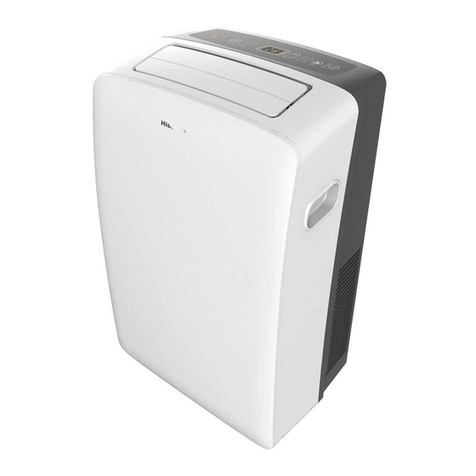
Hisense
Hisense APC09 Use and Installation Instructions




